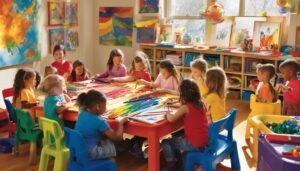When your child picks up a crayon and starts to fill in the lines of a coloring book, they’re not just having fun; they’re developing crucial skills for school. These seemingly simple activities enhance fine motor skills and boost creativity, setting the foundation for academic success. But there’s more to coloring than meets the eye. Understanding its broader impacts can help you better support your child’s growth in these formative years.
Key Takeaways
- Coloring books enhance fine motor skills and hand-eye coordination, essential for writing and using scissors in school.
- Engaging in coloring fosters creativity and cognitive development, preparing children for complex learning experiences.
- Coloring activities improve focus and concentration, laying a strong foundation for academic readiness.
- Collaborative coloring builds social skills, encouraging cooperation and communication in group settings.
- Discussing colors and themes during coloring enhances literacy skills, including vocabulary and narrative comprehension.
Enhancing Fine Motor Skills
Coloring books are more than just a fun pastime; they’re essential tools for enhancing fine motor skills in young children. As your child engages with different coloring techniques, they’re not only enjoying themselves but also practicing vital dexterity exercises.
Gripping crayons or markers helps strengthen their hand muscles, improving coordination and control over time. This process encourages precision, as they learn to stay within lines and experiment with shading. Each stroke develops the skills necessary for future tasks like writing and using scissors.
Boosting Creativity and Imagination
Engaging in coloring activities not only sharpens fine motor skills but also serves as a powerful outlet for creativity and imagination.
When you encourage your child to color, you’re facilitating artistic exploration, allowing them to experiment with colors, shapes, and patterns. This freedom fuels their ability to express themselves uniquely.
Moreover, coloring can spark imaginative storytelling; as they fill in the pictures, they often create narratives around their artwork, enhancing their cognitive skills.
Coloring ignites imaginative storytelling, transforming simple pictures into vibrant narratives that boost cognitive development.
Research shows that such creative play is vital for brain development, helping kids think outside the box and solve problems.
By integrating coloring into their routine, you’re nurturing their creativity, which is essential for success in school and beyond.
Embrace this colorful journey together!
Improving Hand-Eye Coordination
Artistic activities like coloring play a crucial role in enhancing hand-eye coordination in young children. When you encourage your child to use various coloring techniques, they’re not just filling in shapes; they’re developing essential motor skills.
As they grasp crayons or markers, they learn to control their hand movements, which directly improves their coordination. This practice helps them connect what they see with how they move, facilitating better precision in tasks.
Moreover, through artistic expression, kids experience a sense of accomplishment as they create their own vibrant images. By engaging in these activities regularly, you’re setting a strong foundation for their future learning, ensuring they’re better prepared for school and other tasks that require fine motor skills.
Fostering Focus and Concentration
Coloring books can significantly enhance your child’s attention span and concentration, essential skills for success in school.
As they focus on filling in intricate designs, they’re also developing their hand-eye coordination and practicing mindfulness.
These activities not only make learning enjoyable but also lay a strong foundation for academic readiness.
Enhancing Attention Span
While many parents may overlook the benefits of simple activities, using coloring books can significantly enhance a child’s attention span and ability to concentrate. Engaging in coloring requires kids to focus on intricate details and select appropriate coloring techniques, which serves as an excellent attention exercise.
As they immerse themselves in their creations, they’re not only practicing patience but also training their brains to sustain concentration over longer periods. This foundational skill is crucial for school readiness, where attention is often tested in various environments.
Developing Hand-Eye Coordination
A child’s ability to develop hand-eye coordination is significantly enhanced through engaging activities, like using coloring books. When kids practice various coloring techniques, they learn to control their hand movements and improve precision.
This coordination is crucial for everyday tasks, from writing to playing sports. As they color within the lines, children engage in motor skill activities that promote fine motor development. These activities not only sharpen their dexterity but also boost their focus and concentration.
Encouraging Mindfulness Practices
Engaging with coloring books can significantly enhance a child’s ability to practice mindfulness, which in turn fosters focus and concentration. When kids immerse themselves in coloring, they often use techniques like mindful breathing and creative visualization, helping them stay present.
This practice cultivates a sense of calm and improves their attention span.
- Encourages deep breathing to reduce anxiety
- Enhances visual-spatial skills through artistic expression
- Develops patience as they complete intricate designs
- Promotes emotional regulation by expressing feelings through color
- Strengthens cognitive abilities through problem-solving in color choices
Encouraging Patience and Perseverance
When kids color, they learn to focus their attention on completing a task, which is crucial for school readiness.
As they practice mastering fine motor skills, they’re also nurturing patience and perseverance, understanding that good things often take time.
This journey not only enhances their artistic abilities but also builds the emotional resilience they need for future challenges.
Developing Focused Attention
Coloring books provide an excellent avenue for children to develop focused attention, as they require kids to concentrate on intricate designs for extended periods.
This mindful engagement fosters not just creativity, but also the ability to stay on task, which is essential for school readiness.
- Helps kids learn patience as they work through complex images
- Encourages perseverance when they encounter challenging sections
- Instills a sense of accomplishment upon completing a page
- Develops focused practice, enhancing overall concentration skills
- Provides a calming activity that reduces distractions
Mastering Fine Motor Skills
Mastering fine motor skills is crucial for young children as they prepare for school, and coloring books play a significant role in this development. As you guide your child through various coloring techniques, they’ll enhance their grip, control, and precision.
Each stroke of the crayon or marker encourages them to focus on intricate details, fostering patience and perseverance. This artistic expression not only boosts their creativity but also strengthens hand-eye coordination.
When children learn to stay within the lines and experiment with colors, they’re practicing essential skills that translate to writing and other tasks in school. Supporting their journey through coloring can set a strong foundation for their future academic success, helping them become more confident and capable learners.
Building Emotional Resilience
Engaging in coloring activities not only sharpens fine motor skills but also fosters emotional resilience in children. Through coloring, kids learn to navigate their feelings, developing important coping strategies. This creative outlet allows for emotional expression, helping them articulate their thoughts and emotions effectively.
- Coloring requires patience, teaching kids to stay focused on a task.
- Perseverance is built as they work through mistakes and strive for improvement.
- They learn to manage frustration when colors don’t turn out as expected.
- The act of coloring can be calming, reducing anxiety and promoting mindfulness.
- Children gain confidence as they see their completed work, boosting self-esteem.
Supporting Color Recognition and Understanding
As children explore the vibrant world of hues in their coloring books, they naturally begin to recognize and differentiate between colors, laying a crucial foundation for their cognitive development.
Engaging with various shades fosters an understanding of color theory, helping kids grasp how colors relate to one another. For instance, mixing primary colors to create secondary ones illustrates fundamental concepts of color blending.
Additionally, children learn color symbolism, connecting specific colors to emotions and ideas—like red for love or blue for calmness. This exposure not only enhances their visual perception but also enriches their vocabulary as they communicate their preferences.
Ultimately, these activities prepare kids for more complex learning experiences in school, enabling them to engage with the world around them.
Building Confidence and Self-Expression
Coloring books serve as a powerful tool for building confidence and self-expression in young children. As they fill blank pages with color, kids experience a self-esteem boost that encourages them to explore their creative expression. This simple activity allows them to take ownership of their artwork, fostering a sense of pride and accomplishment.
Coloring books empower children to express themselves, boosting their confidence and fostering a sense of pride in their creativity.
- Encourages independent decision-making
- Provides a safe space for experimentation
- Helps develop a personal artistic style
- Reinforces the value of persistence and practice
- Promotes positive self-reflection through completed projects
Through coloring, children learn to embrace their individuality, making it a vital stepping stone for their emotional and social development as they prepare for school.
Promoting Social Skills Through Collaborative Coloring
While many think of coloring as a solitary activity, it can also be a wonderful opportunity for children to build social skills through collaboration.
When kids color together, they engage in social interaction, sharing ideas and techniques that foster collaborative creativity. This teamwork not only enhances their artistic expression but also strengthens relationships as they learn to communicate effectively.
As they negotiate colors and designs, children develop critical skills like empathy and conflict resolution. These experiences prepare them for future group activities in school, where cooperation is essential.
Linking Coloring to Early Literacy Development
Engaging in collaborative coloring not only nurtures social skills but also lays a foundation for early literacy development.
As children immerse themselves in coloring activities, they inadvertently enhance their phonemic awareness and vocabulary enrichment.
Here’s how:
- Recognizing Colors and Shapes: Encourages the use of descriptive language.
- Discussing Characters and Stories: Fosters narrative skills, enhancing comprehension.
- Following Directions: Improves listening skills, vital for phonetic learning.
- Sharing Ideas: Promotes vocabulary use as children express thoughts and feelings.
- Exploring Emotions: Helps articulate feelings, enriching emotional vocabulary.
Frequently Asked Questions
What Age Is Best for Introducing Coloring Books to Children?
You can introduce coloring books around 18 months, as toddlers start reaching key developmental milestones. Engaging in coloring fosters fine motor skills, creativity, and hand-eye coordination, helping your child thrive during crucial early learning stages.
How Do I Select the Right Coloring Book for My Child?
To select the right coloring book for your child, consider that 70% of kids enjoy themed books. Look for coloring themes that spark their interests and incorporate educational content to enhance their learning experience while having fun.
Are There Specific Coloring Techniques That Benefit Learning?
Yes, specific coloring techniques, like shading and blending, enhance fine motor skills and encourage creative expression. These practices not only boost concentration but also foster problem-solving abilities, making learning more engaging and enjoyable for your child.
Can Digital Coloring Apps Provide Similar Benefits as Traditional Coloring Books?
Digital coloring apps can indeed provide benefits like traditional books, blending digital creativity with tactile engagement. However, too much screen time might hinder fine motor skills, making a balance essential for optimal development.
How Often Should Children Engage in Coloring Activities for Maximum Benefit?
For maximum engagement benefits, kids should color several times a week. Consistent coloring frequency enhances fine motor skills and creativity, fostering emotional expression and focus, which are crucial for their overall development and readiness for school.
Conclusion
Incorporating coloring books into your child’s routine isn’t just about fun; it’s a powerful investment in their future. As they color, they’re not only enhancing vital skills but also unlocking their potential for creativity and confidence. Imagine the joy of watching your little one transform a blank page into a vibrant masterpiece, all while preparing for the challenges of school. By nurturing these abilities now, you’re helping them build a strong foundation for lifelong learning and success.




